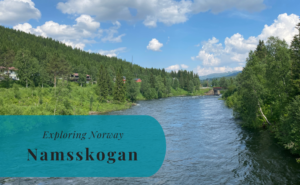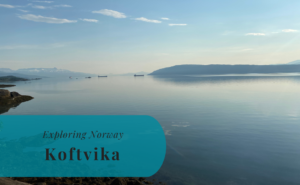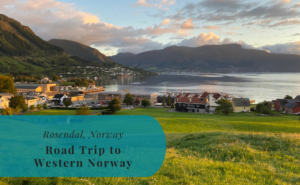Mo i Rana is a town in the district of Helgeland in Nordland County in Northern Norway. It is an industrial hub in the area with a focus on the iron and steel industry. The around 19.000 inhabitants are also joined by Havmannen, the man of the sea. It is Havmannen that is visible on many of the postcards or social media posts from Mo i Rana as he stands a bit out in the water in the fjord Ranfjorden. Looking at the map, it is hard to imagine that this is a coastal town, as the border with Sweden looks to be closer than the coast. But the long fjord does connect the town with the Atlantic Ocean.
Mo i Rana also has names in the different Sámi languages. In Southern Sámi it is Måefie and it Ume Sámi it is Måhvie.





A Short History of Mo i Rana
As is the case with Mosjøen, Mo i Rana has its origins in a farm named Mo. Not the same Mo as Mosjøen, instead this is in “Rana”, which is believed to be related to the fast-moving waters of the fjord Ranfjorden. The latter part of the name has probably been added to distinguish Mo i Rana from the many other places in Norway that have been named Mo.
The area around Mo was a well-known trade post in the region of Helgeland. The trade has mostly consisted of quarry products, smaller boats, and fish. There has also been trading of commodities across the mountainous border with Sweden. In addition, The Sámi People had a market in Mo from 1730 to 1810. It was usually held on the grounds of the church.
Industrialization began at the beginning of the 20th century with the establishment of iron mines in Storforshei a bit outside of Mo i Rana. The availability of hydroelectric power and iron ore provided the foundation needed to open an iron mill in the town. The first steel was produced in 1955 and since then there has been a large development of what is known as Mo Industrial Park. There are today more than 100 established companies here, many of which are in one way or another connected to iron and steel production.





Things to Do and See
The town’s location along the shores of Ranfjorden includes some quite spectacular views. Especially with Havmannen standing out there in the water. There are even a few beaches in case someone wants to have a swim in the quite cold water of the fjord.
Havmannen
Havmannen, or the “Man from the Sea”, is a stone sculpture standing in the water of the Ranfjorden. It is probably one of the most photographed objects in the town and has quite a nice scenery with the fjord, mountains, and nearby harbors in its background. The sculpture was created by the English artist Antony Gormley in 1995. It measures 11 meters in height and weighs 60 tonnes.
Mo i Rana Station
The Mo i Rana stasjon, as it is known in Norwegian, is the local railway station. It has quite an interesting shape, having the form of an octagon. The current station building was opened in 1990 and replaced the original station from 1942. The railway here is a part of the Nordland Line between Trondheim and Bodø.
Mo Church
Mo Church, or Mo Kirke in Norwegian, is the local parish church. It dates back to 1724 and can seat around 400 visitors. This white wooden church is a part of the Evangelical Lutheran Church of Norway.
Rana Museum
The Rana Museum is a part of the regional Helgeland Museum and has exhibitions about the local history. This history includes both the industrial development of the area as well as the native Sámi People.





How to Get to Mo i Rana
- Flights: Mo i Rana Airport (MQN) is 14 kilometers away. It offers mostly domestic flights to towns such as Oslo and Trondheim.
- Car: The town is on road E6 between Mosjøen and Fauske, at the intersection with the E12 that continues to Storuman and Umeå in Sweden.
- Train: The railway connects Mo i Rana with Bodø and Trondheim as well as other stations along the Nordland Line.
The driving distance from 5 major Norwegian cities, according to Google Maps:
- Oslo – 962 kilometers (12 h 42 min)
- Bergen – 1098 kilometers (16 h)
- Trondheim – 474 kilometers (6 h 30 min)
- Narvik – 424 kilometers (6 h 34 min)
- Kirkenes – 1209 kilometers (14 h 50 min)
Find out more about other destinations in Norway by visiting our page Exploring Norway






